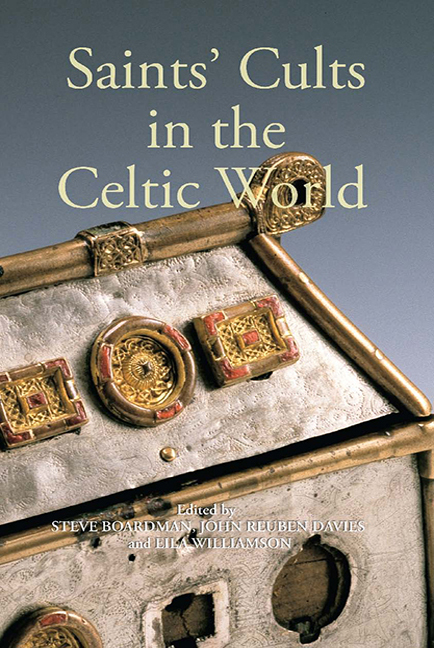Book contents
- Frontmatter
- Contents
- List of Illustrations
- List of Contributors
- Abbreviations
- Editors’ Preface
- 1 Rochester, Hexham and Cennrígmonaid: the movements of St Andrew in Britain, 604–747
- 2 The cults of Saints Patrick and Palladius in early medieval Scotland
- 3 Personal names and the cult of Patrick in eleventh-century Strathclyde and Northumbria
- 4 Bishop Kentigern among the Britons
- 5 Adjacent saints’ dedications and early Celtic History
- 6 Cuthbert the cross-border saint in the twelfth century
- 7 David of Scotland: ‘Vir tam necessarius mundo’
- 8 The cult of Saint George in Scotland
- 9 The cult of the Three Kings of Cologne in Scotland
- 10 The medieval and early modern cult of St Brendan
- General Index
- Miscellaneous Endmatter
1 - Rochester, Hexham and Cennrígmonaid: the movements of St Andrew in Britain, 604–747
Published online by Cambridge University Press: 11 May 2017
- Frontmatter
- Contents
- List of Illustrations
- List of Contributors
- Abbreviations
- Editors’ Preface
- 1 Rochester, Hexham and Cennrígmonaid: the movements of St Andrew in Britain, 604–747
- 2 The cults of Saints Patrick and Palladius in early medieval Scotland
- 3 Personal names and the cult of Patrick in eleventh-century Strathclyde and Northumbria
- 4 Bishop Kentigern among the Britons
- 5 Adjacent saints’ dedications and early Celtic History
- 6 Cuthbert the cross-border saint in the twelfth century
- 7 David of Scotland: ‘Vir tam necessarius mundo’
- 8 The cult of Saint George in Scotland
- 9 The cult of the Three Kings of Cologne in Scotland
- 10 The medieval and early modern cult of St Brendan
- General Index
- Miscellaneous Endmatter
Summary
It is well known that two twelfth-century versions of a foundation legend with common elements claim that the establishment of the cult of the apostle Andrew at Cennrígmonaid, now St Andrews, took place during the reign of a rex Pictorum called Ungus filius Urguist in the shorter, so-called A version of the legend, and Hungus filius Ferlon (recte Forgus) in the longer Version B. The pseudohistorical tendencies of Scottish ecclesiastical foundation legends of this epoch are increasingly widely appreciated. The question of the Andrean dedication at Cennrígmonaid, then, cannot be answered without the help of historians of twelfth-century Scotland. The rest of us have learned, from sneak previews provided in the commemorative volume for the late Marjorie Anderson, that Dauvit Broun and Simon Taylor are in the process of seeking answers, as they work away at new editions of these two foundation legends. This chapter is thus avowedly a hostage to fortune. Under consideration will be some circumstantial evidence that the twelfth-century claim that the founder of Cennrígmonaid was a Pictish king called (H)Ungus is unlikely to be pseudo-historical, whatever one makes of the rest of each legend.
Two Pictish kings attested in contemporary records bore this name. The second of these, Onuist son of Vurguist, was king of Picts for some fourteen years from 820 until 834. The earlier king, also Onuist son of Vurguist, was king of Picts for some thirty years from 732 until 761. Both have had their proponents among past advocates of the partial or entire historicity of the twelfth-century material. The earliest proponent may have been whoever copied the thirteenth-century exemplar of the shorter version of the Pictish king-list, which identified the second Onuist as he who aedificavit Kilremonth (with variants). This identification does not, however, close the case, for Cennrígmonaid is first attested in contemporary records as early as 747, in the obit of its abbot Túathalán ab Cindrighmonaidh.
This eighth-century attestation of a monastery at Cennrígmonaid is invaluable for a number of reasons. For example, it establishes chronological priority in name-forms. It has thus been established that the king-list's Kilremonth is much later in form than Cennrígmonaid, belonging to the twelfth century. The king-list's evidence accordingly becomes unlikely to be much earlier than the thirteenth-century date of its exemplar, and nothing like a contemporary witness to the foundation of the monastery. Attempts have been made to get round this awkward evidence.
- Type
- Chapter
- Information
- Saints' Cults in the Celtic World , pp. 1 - 17Publisher: Boydell & BrewerPrint publication year: 2009

